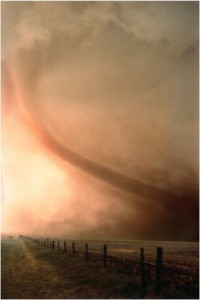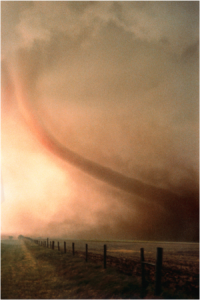This week (May 22) marks the first anniversary of the Joplin tornado, the deadliest tornado since 1950, when modern record keeping began. The devastation (158 fatalities and over 1,000 injured) has strengthened the national commitment to build resilience to extreme weather events. This month’s issue of Scientific American has a great article from NOAA Administrator Dr. Jane Lubchenco and National Weather Service Director Dr. Jack Hayes about how new technologies will increase warning times of impending storms, thereby saving more lives. It is a great article. I was in the Joplin area in September 2005 when I spoke at an event with a local technology firm. When I reached out to my contacts there on the occasion of this difficult anniversary, I heard a consistent story of amazing progress made towards recovery, but there is still a long way to go. They report that visitors are taken aback by the scope of the disaster, even as locals are proud of how far they have come. Perspective is everything.
Archive for the ‘Tornadoes’ Category
One Year Anniversary of Joplin Tornadoes
Friday, May 25th, 2012Did a Tornado Strike New York City Today?
Thursday, September 16th, 2010A short burst of intense storm activity disrupted us in New York City this evening. The National Weather Service is evaluating meteorological data to determine if the storm can be classified as a tornado, as it presented 60 – 80 mile per hour winds. The damage is certainly suggestive of a tornado, with powerful winds knocking over trees and hurling them on power lines, thereby causing electrical outages. ConEdison is reporting power failures in various locations in the city. The Long Island Railroad canceled commuter service this evening when fallen trees disrupted service. Displaced passengers tried to use the subways instead, forcing officials to close Pennsylvania Station (where subway and train lines converge) due to overcrowding. Subway service resumed several hours later, but as I write this post, I can see long queues for taxi service owing to the delays or cancellations of public transportation lines. This is one that caught us by surprise. I am just glad that I was indoors when it struck. 2010 has certainly been a year for extreme weather events.
A Disastrous Weekend
Sunday, June 20th, 2010The weekend began with a series of giant tornadoes tearing through Minnesota, destroying buildings and causing at least three deaths. The National Weather Service received 36 reports of tornado sightings which, if all are confirmed, would exceed the previous record of 27 tornadoes striking Minnesota in a single day, back in 1992.
Estimates of the volume of oil leaking each day into the Gulf of Mexico were revised upward as more information about the extent of the rig damage came to light. More Gulf Coast tourism and fishing businesses closed as a consequence of the environmental damage. USA Today published an excellent article about the disaster fatigue suffered by Gulf Coast residents who are “forever in recovery” as Katrina-inflicted damage is still with them even as they face the consequences of the oil spill.
The southern states experienced an extreme heat wave, with temperatures in the high 90s/100s. And summer doesn’t officially begin until tomorrow! We are in for a tough weather season. To get you thinking about updating your disaster recovery plan, check out the following article by Inc. magazine columnist Donna Fenn.
Tornadoes Strike Ohio and Michigan
Tuesday, June 8th, 2010 Tornadoes and thunderstorms struck the Midwestern states this weekend. In Ohio, the tornadoes killed at least seven people and destroyed homes and commercial buildings along a seven-mile trajectory path. The storm also knocked out emergency 911 dispatchers for a brief period. Thankfully, the storm missed the more heavily populated communities around Toledo. In Michigan, the storms caused cosmetic damage to a nuclear reactor, causing a safety protocol to initiate an automatic shutdown. More than 30,000 people were left without power, possibly due to the nuclear plant’s shutdown or to damaged power lines in the area.
Tornadoes and thunderstorms struck the Midwestern states this weekend. In Ohio, the tornadoes killed at least seven people and destroyed homes and commercial buildings along a seven-mile trajectory path. The storm also knocked out emergency 911 dispatchers for a brief period. Thankfully, the storm missed the more heavily populated communities around Toledo. In Michigan, the storms caused cosmetic damage to a nuclear reactor, causing a safety protocol to initiate an automatic shutdown. More than 30,000 people were left without power, possibly due to the nuclear plant’s shutdown or to damaged power lines in the area.
One of the key takeaways of this weekend storm is that every natural disaster comes with a threat of power outages. It is uncertain how soon power will be restored to the affected area in Michigan, but consider solutions for your business that address this threat. Do you sell products on your website? Perhaps a hosted e-commerce solution can ensure that your online store stays up and running even when your office is down. Are there contingent service providers you can retain to perform certain of your functions remotely when your office power is knocked out? Assess the sensitivity of your revenues to these risks and plan accordingly.
Tornadoes Strike Kansas and Oklahoma
Thursday, May 13th, 2010Multiple tornadoes struck Oklahoma and Kansas, raining down hailstones the size of baseballs. The storms left more than 65,000 businesses and homes without power. Gas leaks, downed power lines and ground debris have created hazardous conditions in some areas. At least 60 people were injured and emergency officials believe at least two people were killed in the storm. As this is tornado season, it is worth reviewing the safety information about these powerful storms, quoted from pages 94 – 95 of Prepare for the Worst, Plan for the Best: Disaster Preparedness and Recovery for Small Businesses (Wiley, paperback, second edition, 2009):
“Although tornadoes are more common in the Midwestern states, the fact is that they have been reported in each of the 50 states in America and in countries throughout the world. Even if you think you do not live in a tornado- prone area, read this section for the safety information. On April 24, 2007, a tornado tore through Eagle Pass, Texas, causing at least ten fatalities and injuring more than 80 people. Two elementary schools were demolished and almost 300 people were evacuated to shelters. This was an area that is not associated with tornado activity!
Tornadoes are known as “twisters” because tornado winds gust at speeds in excess of 200 miles per hour, destroying everything in their path. Spring and Summer are considered the tornado “seasons,” but they can happen at any time of the year. A tornado watch means that a tornado is possible in your area; a tornado warning means that a tornado has already been sighted. An approaching tornado sounds like a speeding train. Remain indoors, away from the windows that could be shattered by the high-speed winds. If you are in a high-rise building, try to make it to the basement safely. I recommend that you avoid the elevators and take the stairs as fallen power lines could disrupt the supply of electricity to your building without warning. If you don’t have sufficient time to go to the basement or the ground floor, move to the center of the building, which is as far removed from windows on either side of the building as possible. If you are outside, go to the basement of the nearest sturdy building or lie flat in a ditch or a low-lying area. If you are in a car or a mobile home, get out immediately.
As is the case with a hurricane or a flood, remember to bring any equipment that is outside indoors. I have two friends, a husband and wife team, who own and operate a charming inn in New England. The inn caters to vacationing families, and, as such, has outdoor toys, swing sets, picnic tables, barbecues, and other items that could get swept in high winds and cause injuries. Their contingency plan calls for the husband to ensure that the items on the northern and eastern side of the inn are brought indoors when a storm warning is in effect, while the wife is responsible for the lower-weight items on the southern and western side of the inn. By assigning responsibilities, they ensure that nothing will be overlooked.
Once the tornado has passed, check your premises for damage. Be careful when you leave your premises, as fallen power lines pose a particular hazard. Don’t light matches or use candles, as there may be gas leaks of which you are unaware. Listen to the news reports to determine if it is safe to go home and which areas you should avoid on your commute home.”
Deadly Tornadoes Strike Mississippi
Monday, April 26th, 2010Over the weekend, tornadoes with wind speeds in excess of 160 mph struck an area at least 50 miles long from Louisiana to central Mississippi, killing at least 12 people and injuring more than three dozen others. Hundreds of homes were damaged in the storm. Although tornadoes are more common in the Midwestern states, the fact is that they have been reported in each of the fifty states and countries throughout the world. This is a sad reminder of the need to stay up to date on tornado safety. Here are some tips from Prepare for the Worst, Plan for the Best: Disaster Preparedness and Recovery for Small Businesses (Wiley, second edition 2008):
Tornadoes are known as “twisters” because tornado winds gust at speeds in excess of 200 miles per hour, destroying everything in their paths. Spring and summer are considered the tornado “season”, but they can happen at any time of the year. A tornado watch means that a tornado is possible in your area; a tornado warning means that a tornado has already been sighted. An approaching tornado sounds like a speeding train. Remain indoors, away from the windows, which could be shattered by the high-speed winds. If you are in a high-rise building, try to make it to the basement safely. We recommend that you avoid the elevators and take the stairs as fallen power lines could disrupt the supply of electricity to your building without warning. If you don’t have sufficient time to go to the basement or the ground floor, move to the center of the building, which is as far removed from windows on either side of the building as possible. If you are outside, go to the basement of the nearest sturdy building or lie flat in a ditch or a low-lying area. If you are in a car or a mobile home, get out immediately.
Once the tornado has passed, check your premises for damage. Be careful when you leave your premises, as fallen power lines pose a particular hazard. Don’t light matches or use candles, as there may be gas leaks of which you are unaware. Listen to the news reports to determine if it is safe to go home and which areas you should avoid on your commute home.
Tornadoes Strike Louisiana and Arkansas
Friday, October 30th, 2009 At least three tornadoes struck northwestern Louisiana and at least two tornadoes struck Arkansas, both arising from thunderstorms. USA Today has a great interactive graphic showing how tornadoes form. Heavy rains in connection with the storms flooded roads in Arkansas. In Shreveport, Louisiana, the tornado blew a landmark steeple off of a church, which hit a car, trapping the driver who had to be removed from his vehicle by rescuers. He suffered broken bones, but another driver died when his car hit a tree knocked down by the storms. These tornadoes come as the peak of what has turned out to be a very mild hurricane season is behind us, a sober reminder of the diverse risks we face.
At least three tornadoes struck northwestern Louisiana and at least two tornadoes struck Arkansas, both arising from thunderstorms. USA Today has a great interactive graphic showing how tornadoes form. Heavy rains in connection with the storms flooded roads in Arkansas. In Shreveport, Louisiana, the tornado blew a landmark steeple off of a church, which hit a car, trapping the driver who had to be removed from his vehicle by rescuers. He suffered broken bones, but another driver died when his car hit a tree knocked down by the storms. These tornadoes come as the peak of what has turned out to be a very mild hurricane season is behind us, a sober reminder of the diverse risks we face.
Geography Is Not Destiny
Wednesday, June 10th, 2009When serving as the keynote speaker at the annual entrepreneurs’ award luncheon of the Colorado Springs Small Business Development Center, I spoke of the risk of Colorado’s favorable geography. Disaster-prone locales tend to have heightened awareness of risk threats, whether it is small businesses in California attuned to earthquake risks or Gulf Coast small businesses concerned about hurricanes. The happy fact that Colorado Springs is not located on a geological fault line or a coast can give rise to complacency. Consider, for example, that in any given year, 30% of the areas that flood have never before flooded and are not located in flood plains. While flood is a much more significant risk than either hurricane or earthquake, it is not this peril, but the underlying principle is that it is the everyday risk that is the more imminent threat. Today, a citizen journalist in Colorado posted on the CNN website a video of a tornado in his community. So what is the take home message? Focus on preparing for the everyday disaster, such as human errors and power outages, and this way you will gradually build resilience for the more serious disasters. This is critical because you cannot always predict on the basis of your locale the more severe disaster that will threaten you. It may be a flood or tornado that has never before struck your community.
Twisters Can Strike Anywhere
Tuesday, April 14th, 2009 Over the past week, more than twenty deadly tornadoes struck in Arkansas, Louisiana, Missouri, Oklahoma, Tennessee and Texas. Although typically associated with the midwestern part of the country, tornadoes have been reported in all fifty states. They can occur at any time of year but in the southern states, peak tornado activity usually occurs during the months of March through May. Tornado activity increases in the northern states during the summer months. Tornadoes can strike at any hour, but they most often happen between the hours of 3:00 – 9:00 p.m. Tornadoes are known as “twisters” because wind speeds can gust in excess of 200 miles per hour. A tornado watch means that a tornado is possible in your area; a tornado warning means that a tornado has already been spotted in your community. An approaching tornado sounds like a speeding freight train.
Over the past week, more than twenty deadly tornadoes struck in Arkansas, Louisiana, Missouri, Oklahoma, Tennessee and Texas. Although typically associated with the midwestern part of the country, tornadoes have been reported in all fifty states. They can occur at any time of year but in the southern states, peak tornado activity usually occurs during the months of March through May. Tornado activity increases in the northern states during the summer months. Tornadoes can strike at any hour, but they most often happen between the hours of 3:00 – 9:00 p.m. Tornadoes are known as “twisters” because wind speeds can gust in excess of 200 miles per hour. A tornado watch means that a tornado is possible in your area; a tornado warning means that a tornado has already been spotted in your community. An approaching tornado sounds like a speeding freight train.
Remember the basic precautions for tornado safety: try to go to the basement for shelter. Avoid the elevators and take the stairs. If you do not have time to make it safely to the basement, move towards the center of the building, away from the windows. If you are in a car or a mobile home, get out of there immediately. Remember to bring any equipment that is outside indoors, such that it cannot get swept away by high-speed winds and used as an instrument to cause harm. Power outages are common in the aftermath of tornadoes, so don’t light matches as there may be gas leaks of which you are unaware. Make sure that all of your employees are familiar with basic safety practices to exercise when a tornado warning has been called and encourage them to share this information with their families.



